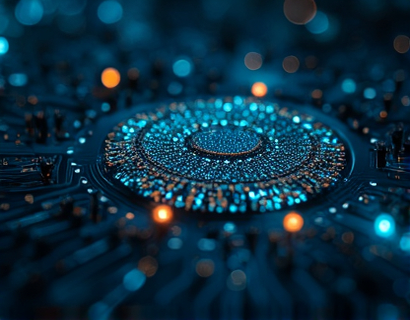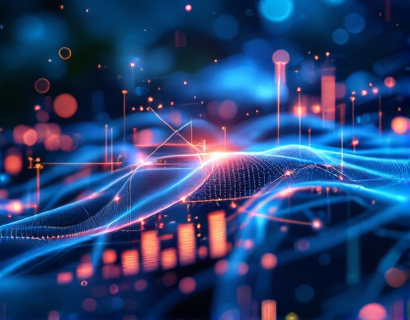Unlocking Digital Potential: Harnessing Crypto and AI for Next-Gen Productivity Solutions
The intersection of cryptocurrency and artificial intelligence (AI) is giving rise to a new era of productivity solutions. This convergence is creating advanced applications and services that promise to simplify daily tasks and revolutionize the way we work. As tech-savvy innovators and early adopters continue to explore this space, the potential for transformative change becomes increasingly evident. This article delves into the ways in which crypto and AI are being harnessed to develop next-generation productivity tools, offering insights into the technologies driving this revolution and the benefits they bring to users.
The foundation of this new wave of productivity solutions lies in the unique properties of blockchain technology and the computational power of AI. Blockchain provides a decentralized, secure, and transparent platform for transactions and data management, while AI brings intelligent automation and predictive analytics to the table. When combined, these technologies can create systems that are not only efficient and secure but also capable of learning and adapting to user needs.
Decentralized Productivity Platforms
One of the most significant applications of blockchain in productivity is the development of decentralized platforms. These platforms eliminate the need for intermediaries, reducing costs and increasing efficiency. For instance, decentralized file storage solutions leverage blockchain to ensure data integrity and security, allowing users to store and share files without relying on centralized servers. This not only enhances privacy but also ensures that data is resilient against censorship and outages.
Decentralized productivity tools, such as collaborative workspaces and project management systems, are also emerging. These tools use blockchain to create transparent and tamper-proof records of tasks, deadlines, and contributions. This transparency fosters trust among team members and ensures accountability, which is crucial for remote and distributed teams. By removing the need for centralized control, these platforms empower users to collaborate more effectively and efficiently.
AI-Powered Task Automation
AI is playing a pivotal role in automating repetitive and time-consuming tasks, freeing up users to focus on higher-value activities. Smart assistants and virtual agents powered by AI can manage schedules, send reminders, and even draft emails, all while learning from user preferences and behavior. These tools can integrate with various productivity applications, creating a seamless workflow that adapts to individual needs.
Machine learning algorithms can analyze large datasets to identify patterns and provide insights that can inform decision-making processes. For example, AI can predict project timelines, resource allocation, and potential bottlenecks, enabling proactive management and optimization. This level of insight is particularly valuable in complex projects where traditional methods may fall short.
Enhanced Security and Privacy
Security and privacy are paramount in the digital age, and the combination of crypto and AI offers robust solutions. Blockchain's inherent security features, such as cryptographic hashing and consensus mechanisms, ensure that data is protected from unauthorized access and tampering. AI can further enhance security by detecting and mitigating threats in real-time, identifying anomalies and potential vulnerabilities.
Privacy-preserving technologies, such as zero-knowledge proofs and homomorphic encryption, allow users to perform computations on encrypted data without revealing the underlying information. This means that sensitive information can be processed and analyzed securely, without compromising user privacy. For businesses and individuals alike, this level of security and privacy is invaluable in an era where data breaches and cyber threats are increasingly common.
Personalized Productivity Insights
AI-driven analytics can provide personalized insights and recommendations to enhance individual productivity. By analyzing user behavior and performance data, these systems can identify areas for improvement and suggest tailored strategies. For example, AI can analyze a user's work patterns to recommend optimal times for focused work, breaks, and meetings, based on their productivity peaks and troughs.
Personalized learning and skill development are also possible through AI-powered platforms. These platforms can curate content and training modules based on a user's current skills and learning objectives, ensuring that the learning process is both efficient and effective. This level of personalization is particularly beneficial in fast-paced industries where continuous learning and skill upgrades are essential.
Interoperability and Integration
The true power of crypto and AI in productivity solutions lies in their ability to integrate seamlessly with existing systems and tools. Interoperability ensures that different applications and platforms can communicate and work together, creating a cohesive ecosystem. This is achieved through the use of open standards and protocols, such as API integrations and decentralized identifiers (DIDs).
For instance, a user's productivity data can be securely shared across multiple applications, allowing for a unified view of tasks, progress, and performance. This not only streamlines workflows but also reduces the need for manual data entry and synchronization. As more tools adopt these standards, the ecosystem becomes more robust and user-friendly, encouraging wider adoption.
Case Studies and Real-World Applications
Several real-world examples illustrate the practical applications and benefits of crypto and AI in productivity. One notable example is a decentralized cloud storage service that uses blockchain to ensure data integrity and AI to optimize storage and retrieval processes. Users can store their files securely and access them from anywhere, with the AI system intelligently managing storage costs and performance.
Another example is an AI-powered project management tool that integrates with various crypto-based incentive systems. Team members can earn tokens for completing tasks and contributing to the project's success, which can be redeemed for various rewards. This gamification approach not only boosts motivation but also aligns individual efforts with the project's goals.
Challenges and Considerations
While the potential of crypto and AI in productivity solutions is vast, there are several challenges and considerations to keep in mind. One of the primary challenges is the technical complexity involved in integrating these technologies. Developers need to have a solid understanding of both blockchain and AI to create effective and user-friendly applications.
Regulatory uncertainty is another factor to consider. The crypto space is still evolving, and regulations vary widely across jurisdictions. Ensuring compliance and navigating the legal landscape is crucial for the successful deployment of these solutions. Additionally, user education is essential, as many individuals may be unfamiliar with these technologies and their benefits.
Future Outlook
The future of productivity solutions at the intersection of crypto and AI is promising. As technology continues to advance, we can expect even more innovative applications and services to emerge. The integration of quantum computing, for instance, could further enhance the computational capabilities of AI, leading to more sophisticated and efficient productivity tools.
Moreover, the growing adoption of Web3 principles, which emphasize decentralization, user sovereignty, and transparency, aligns perfectly with the goals of crypto and AI-driven productivity solutions. This convergence is likely to create a more inclusive and empowering digital landscape, where users have greater control over their data and workflows.
In conclusion, the combination of cryptocurrency and artificial intelligence is unlocking new possibilities for productivity solutions. By leveraging the strengths of both technologies, we can create systems that are secure, efficient, and tailored to individual needs. As more developers and organizations embrace this vision, the future of digital productivity looks brighter than ever.










































